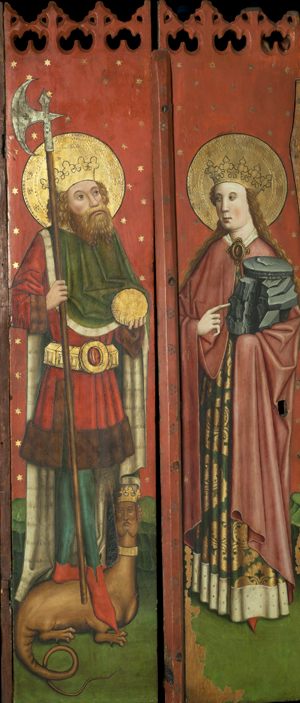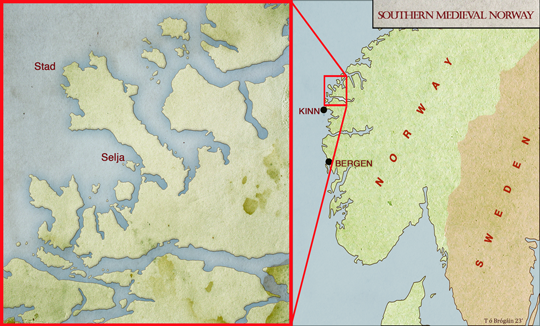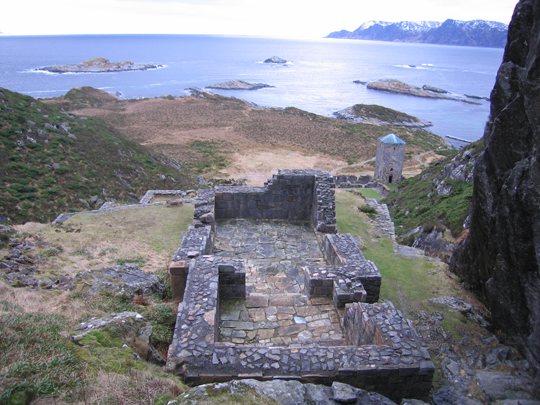ST SUNNIVA—IRELAND’S MEDIEVAL MARTYR-QUEEN
Published in Features, Issue 3 (May/June 2023), Volume 31By Meredith Cutrer

Above: The two main Norwegian medieval saints, St Olaf and St Sunniva, a king and a queen, as depicted c. 1460 on the front of the tabernacle shrine from Granvin by the Hardanger fjord, western Norway. (Svein Skare/University Museum of Bergen)
The 7th of September 1170 marked a momentous occasion in Bergen, Norway: the relics of the Irish martyr-queen Sunniva were transferred from the island of Selja, off Norway’s western coast, to Bergen’s Cathedral of Christ Church. Sunniva’s cult played a consequential role in the ambitions of Norwegian kings and clerics and was an integral part of Bergen’s identity. Her remarkable story and posthumous fame propelled her to prominence as the patron saint of Bergen and western Norway, securing Sunniva’s status as one of Norway’s most important figures of the Middle Ages and one of its most prominent saints to this day. Since the status of saints was affirmed in their local diocese before 1215, Sunniva was never canonised by Rome. Nevertheless, she boasts a cult that extended from Iceland to Finland, from Germany to Finnmark. Despite her reputed Irish heritage, Sunniva is largely unknown in Ireland, even as the celebration of her cult is increasingly popular in Norway.
HER STORY
According to her anonymous twelfth-century Norwegian legend, Sunniva was born in Ireland to a Christian royal family in the tenth century. She was heir to the throne and sole control of her father’s kingdom was conferred on her upon his death. Her kingdom was peaceful until she attracted a wicked ruler’s notice. In a failed attempt to coerce Sunniva into marriage, the tyrant threatened to destroy her land and oppress her people.
Despite the tyrant’s aggression, Sunniva refused marriage. She fled Ireland with a number of her subjects, leaving their fate in God’s hands as they departed into exile without oars in a nod to a well-established trope of medieval Irish literature. The company arrived in the waters off Norway. After a storm separated them, some arrived at the island of Kinn, while Sunniva and the rest of her entourage found refuge on the nearby island of Selja, which was inhabited only by sheep owned by people on the mainland nearby.
On Selja the Irish resided in caves until the flocks’ owners falsely accused them of stealing. They asked their ruler, Jarl Hákon, to retaliate, but the pagans’ ambitions to kill the Irish themselves were thwarted. Seeing their imminent end, the Irish prayed for deliverance through death, but a death at the hands of God rather than those of the pagans. So God sent an angel, who collapsed their cave, crushing Sunniva and her people. The pagans were unable to find the martyrs, whose bodies remained in the cave.
Selja’s holiness was then discovered when merchants in their ships saw a mysterious light emanating from the island. Seeking the light’s source, they found that it radiated from a pleasantly scented skull. The merchants took the skull to the Christian king Óláfr Tryggvason, whose bishop placed it among the relics of other saints. The merchants’ account of the miracles on Selja was confirmed by so many that it prompted both the king and the bishop to visit the place. There, on the west side of the island where the mountain had collapsed, they found bones with a delightful aroma among the rocks.
As the Christians gathered the martyrs’ relics, they discovered Sunniva’s body. The king and bishop built a church there, and the Irish saints’ bones were placed in the church on Selja in 996, before Sunniva’s translatio in 1170 to the Cathedral of Christ Church, Bergen’s most important medieval church until the Reformation in the 1530s. The relics were elevated above the high altar until Norway’s adoption of Lutheranism, when the cathedral was destroyed, the sanctuary at Selja was abandoned and the relics disappeared, only to be rediscovered in 1849 when some of the Irish saints’ bones were found in a medieval altar slab. These relics are now incorporated into the altar of St Magnus’s Catholic Church in Lillestrøm, east of Oslo.
A CURIOUS QUEEN
Sunniva is an unusual figure in both Norwegian and Irish traditions. While Irish in ethnicity, her name is Anglo-Saxon, deriving from Sungeofa, meaning ‘sun gift’, a name attested primarily in north-eastern England in the eleventh and twelfth centuries, when her legend was written. She is the only female saint martyred on Norwegian soil, and many consider the Selja saints Norway’s first. The Irish refugees’ martyrdoms are also unusual: they were killed by an angel of God, not by pagans.
Sunniva’s martyrdom breaks the mould of Irish saints. Ireland was believed (erroneously) by many in the Middle Ages to boast no martyrs, a point that the twelfth-century English Hibernophobe Gerald of Wales used in the 1186 synod convened at Dublin’s Christ Church Cathedral as evidence of Irish inferiority in religious matters. There are, however, no martyred royal saints in Irish tradition. Furthermore, saints in medieval Ireland were primarily male and monastic. Female Irish saints were not secular like Sunniva, who was not bound by vows to a religious order. And though Sunniva is a patron saint in Norway, her legend casts her as playing no obvious role in Christianising Scandinavia, which makes her an unusual candidate for such an exalted position.
Elements of her story suggest that Sunniva never existed. Her legend probably developed from a pre-existing tradition surrounding bones found on Selja that were revealed by a mysterious light just prior to the advent of Christianity in Norway. While Norwegians long considered Selja a sacred site, it was not until the anonymous bones were attributed to Sunniva and her Irish compatriots that they had a fully developed origin-story.
‘REJOICE, BLESSED IRELAND, IN THE GLORY OF YOUR QUEEN!’
This line, which begins a medieval Norwegian antiphon in the liturgy on 8 July, Sunniva’s feast-day, exhorts the Irish to celebrate her, but Sunniva’s Irish ancestry marks one of the first indications that her story was likely fabricated. While her tale begins in Ireland, curiously this queen is found nowhere in contemporary Irish sources. Furthermore, the limited information that her tale provides about Ireland is dubious. For instance, Sunniva’s legend tells of her inheriting a kingdom upon her father’s death and ruling alone, yet such an ascent to the throne by a woman would have been nearly impossible in medieval Ireland.
Sunniva’s legend is one of several pieces of medieval literature that cast Irish women as independently powerful political agents, a status that no surviving historical source substantiates. Such literature has resulted in a prevalent but mistaken belief concerning the extent of the freedom enjoyed by women in medieval Ireland. The Irish annals record no solo female monarchs, but there is evidence of pervasive and systemic misogyny. The c. ninth-century wisdom text Tecosca Cormaic places an extensive catalogue of women’s weaknesses into the mouth of King Cormac mac Airt. The piece provides insight into medieval Irish attitudes towards women, who are referred to as ‘capricious beasts’. Cormac warns his successor Cairpre that women are ‘deaf to instruction’, ‘blind to good advice’, are better ‘beat[en]’ than ‘coddle[d]’, and much more besides, indicating that the author of this Old Irish text delineating good kingship did not consider women constitutionally fit for leadership, or suitable for anything worthwhile for that matter. The author’s sentiments were not unusual, and though some legal tracts do afford certain women more value than the Tecosca Cormaic, there is no clear evidence for autonomous female monarchs.
To cast further doubt on the reality of Sunniva’s cognatic succession (a royal succession that permits either a male or a female heir), the position of a ruler in medieval Ireland was not inherited, thus casting doubt on the legend’s claim of her hereditary right to the throne. In medieval Ireland rulers were selected from a pool of qualified candidates. A person vying for kingship had to be a member of, and be a considerable landowner in, an élite three-generation patrilineal kin group, which would likely have restricted women from legitimate succession. Ireland’s hierarchical social structure, which it codified into and upheld through its vernacular legal tradition, would have made it nearly impossible for a woman to rule a kingdom alone in the tenth century.
CLAIMANT TO THE CROWN
Sunniva’s legend conveniently aligns with the political ambitions of the period in which it was written. It is likely that key attributes ascribed to Sunniva were given to meet the political and religious needs of the twelfth-century world that gave life to her legend. Sunniva’s cognatic succession is interesting given the political context of twelfth-century Norway. Medieval Norway only allowed for agnatic succession (i.e. through the male bloodline) to the throne, so Sunniva’s succession would also have contravened Norwegian custom. If Sunniva never existed, but rather was constructed with features to suit the agenda of her cult’s promoters, what purpose did her cognatic succession serve?
Though the general contours of the Irish martyrs’ stories were known in Norway prior to the writing of her legend, Sunniva’s narrative as we have it now was likely written around 1170 when her relics were moved from Selja to Bergen. This is less than a decade into the vulnerable reign of Norwegian child-king Magnús Erlingsson, who was crowned in 1163/4 in Bergen’s Christ Church Cathedral, the same cathedral to which Sunniva’s relics were moved shortly thereafter. The timing and location of her relics’ translation and the timing of the legend’s composition seem intended to legitimise Magnús’s kingship, especially in light of the contemporary trend whereby European royals bolstered their status through connections to royal saints. Given Norway’s tradition of agnatic succession and the competition from several viable contenders for the throne, Magnús’s claim through his mother, King Sigurd the Crusader’s (Sigurðr Jórsalafari) daughter, Kristín Sigurðsdottír, was comparatively weak. Having ties to an esteemed royal saint whose own legend affirmed the right to rule through the female line was advantageous for Magnús.
Around this time a law of succession was introduced which stipulated that designated individuals would decide the next king when the previous king had no legitimate sons. This law would have further affirmed Magnús’s claim to the throne, as leading officials had appointed him. The law’s passage suggests that Magnús’s circle sought to bolster his kingship. Aspects of the Irish martyr-queen’s legend and her relics’ translation, then, aligned opportunely with the political and religious ambitions of twelfth-century Norwegian leaders. They capitalised on her cognatic succession and her final resting-place in Magnús’s coronation church as an opportunity to affirm the right of both Magnús and his descendants to the Norwegian throne.
‘ISLAND OF SAINTS’

Above: Southern part of medieval Norway, showing the islands of Selja and Kinn and the city of Bergen, the main cult centres connected to St Sunniva. (Tomás Ó Brogáin)
The dubious nature of Sunniva’s time in Ireland gives the impression that the legend’s author knew little about Ireland. We can safely surmise that he was not Irish, and it has been argued that he was connected to English Cistercians living in Norway. This raises the question as to why a non-Irish author constructing a saint intended for Norwegians would attribute a spurious Irish identity to his protagonist.
In the twelfth century, when Sunniva’s legend was composed, attributing Irish origins to non-Irish saints was in vogue elsewhere in Europe. Sunniva’s Irish ancestry is not incidental but rather was meant to accentuate her holiness, a trait long associated with Ireland. The Irish had been sending clerics and scholars abroad since at least the sixth century. Devout Irish exiles and émigrés like Columbanus, Columba, Dícuil and Eriugena were influential abroad as scholars and monastic founders. The outsized impact of Irish Christians on the Continent established Ireland’s reputation as an island of particular sanctity. Sunniva’s Irish ancestry conferred on her a pedigree that placed her in the tradition of other holy Irish exiles.
SUNNIVA TODAY
In the wake of the sixteenth-century Reformation, Sunniva’s cult nearly disappeared from memory until the nineteenth and twentieth centuries, when Norway began to re-establish its national identity apart from Denmark and Sweden. The increasing interest in the Irish-born queen is reflected in heritage initiatives like the festivals and productions staged in her honour and the notable rise in Norwegian mothers naming their daughters Sunniva or some variant (e.g. Synneve, Synøve, Synne, Sinniva etc.) in the late twentieth century. She has made her way into myriad pieces of modern art and literature, where she has been reimagined by contemporary Norwegians—just like their medieval forebears—to speak to our times. Today Sunniva is still revered as a holy queen and martyr, but some authors reinterpret her in a more secular manner, envisioning her without her virginity, sanctity and devotion. Sunniva’s role as both a canvas for and a mirror to Norwegian society continues unabated in the 21st century.
One of the clearest indications of Sunniva’s increasing importance in modern Norwegian consciousness is the promotion of pilgrimage routes celebrating the Irish-born saints along Norway’s western coast. One popular route, the Sunnivaleia, takes pilgrims on an approximately one-week pilgrimage to sites associated with the Irish martyrs, including Bergen and the islands of Kinn and Selja. A modern group of pilgrims to Selja gifted the island with an Irish-made cross, representing the coming of Christianity from Ireland and Britain to Norway and reaffirming the close ties between Selja and Ireland. These pilgrimage routes connect modern seekers with Norway’s sacred past in general and with Sunniva’s story in particular in profound ways.

Above: The ruins of St Sunniva’s church on the island of Selja. The tower of the Benedictine abbey church of St Alban can be seen at a lower level to the right. (A.T. Hommedal)
Sunniva’s importance as a figure in Norway need not be diminished by whether or not she existed historically. For many Christians, Sunniva, the ‘sun gift’, can be understood as a personification of the light brought to Norway with the arrival of Christianity from the West and with it the power to transform the very fabric of society. For contemporary secular communities, there is remarkable diversity in the way she is remembered. Sunniva is represented variously as the epitome of an empowered heroine on the one hand or as a victimised refugee on the other. To numerous Norwegians, however, Sunniva is a powerful symbol of identity, an Irish martyr-queen and Norwegian patron saint whose story, reimagined and retold, continues to speak to contemporary sensibilities.
Meredith Cutrer is a doctoral candidate at Oxford University specialising in early medieval history.
Further reading
A.T. Hommedal, ‘A holy cave and womb: the sanctuary on the island of Selja and the birth of the first Norwegian saints’, in K.A. Bergsvik & M. Dowd (eds), Caves and ritual in medieval Europe, AD 500–1500 (Oxford, 2018), 63–84.
A.T. Hommedal, Å. Ommundsen & A. O’Hara, St Sunniva: Irish queen, Norwegian patron saint (Bergen, 2021).
A. O’Hara, ‘Constructing a saint: the legend of St Sunniva in twelfth-century Norway’, Viking and Medieval Scandinavia 5 (2009), 105–21.
















